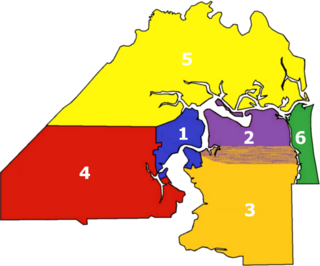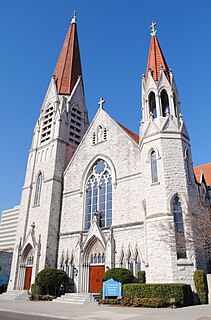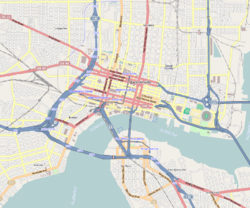
Carpenter Gothic, also sometimes called Carpenter's Gothic or Rural Gothic, is a North American architectural style-designation for an application of Gothic Revival architectural detailing and picturesque massing applied to wooden structures built by house-carpenters. The abundance of North American timber and the carpenter-built vernacular architectures based upon it made a picturesque improvisation upon Gothic a natural evolution. Carpenter Gothic improvises upon features that were carved in stone in authentic Gothic architecture, whether original or in more scholarly revival styles; however, in the absence of the restraining influence of genuine Gothic structures, the style was freed to improvise and emphasize charm and quaintness rather than fidelity to received models. The genre received its impetus from the publication by Alexander Jackson Davis of Rural Residences and from detailed plans and elevations in publications by Andrew Jackson Downing.

The Great Fire of 1901 was a conflagration that occurred in Jacksonville, Florida, on Friday, May 3, 1901. It was one of the worst disasters in Florida history and the third largest urban fire in the U.S., next to the Great Chicago Fire, and the 1906 San Francisco fire.

Downtown Jacksonville is the historic core and central business district (CBD) of Jacksonville, Florida USA. It comprises the earliest area of the city to be developed and is located in its geographic center along the narrowing point of the St. Johns River. There are various definitions of what constitutes Jacksonville's downtown; the one used by the city government and other entities defines it as including eight districts: the Central Core, the Southbank, LaVilla, Brooklyn, the Working Waterfront, the Cathedral, the Church, and the Entertainment & Sports District. The area features offices for major corporations such as CSX Corporation, Fidelity National Financial, TIAA Bank, Black Knight Financial, One Call Care Management, Suddath, Interline Brands Haskell, FIS, and Stein Mart.

There are more than 500 neighborhoods within the area of Jacksonville, Florida, the largest city in the contiguous United States by area. These include Downtown Jacksonville and surrounding neighborhoods. Additionally, greater Jacksonville is traditionally divided into several major sections with amorphous boundaries: Northside, Westside, Southside, and Arlington, as well as the Jacksonville Beaches.

Saint George Episcopal Church is an historic Carpenter Gothic style Episcopal church located at 10560 East Fort George Road on Fort George Island in Jacksonville, Florida in the United States. Built in 1882–1883, it was designed by architect Robert S. Schuyler of nearby Fernandina.

The St. James Building is an historic building in Downtown Jacksonville, Florida, currently housing Jacksonville City Hall. It was designed by architect Henry John Klutho and opened in 1912. One of many structures in downtown Jacksonville designed by Klutho after the Great Fire of 1901, it is considered his Prairie School masterpiece.

The Woman's Club of Jacksonville was an historic woman's club in Jacksonville, Florida. It was located at 861 Riverside Avenue, next to the Cummer Museum of Art and Gardens. On November 3, 1992, it was added to the U.S. National Register of Historic Places.

The Basilica of the Immaculate Conception is a historic Catholic church in Downtown Jacksonville, Florida, U.S. A parish church in the Diocese of St. Augustine, it represents Jacksonville's oldest Catholic congregation. The current building, dating to 1910, was added to the U.S. National Register of Historic Places in 1992 as the Church of the Immaculate Conception, and was named a minor basilica in 2013. It is located at 121 East Duval Street; its current pastor is Very Reverend Blair Gaynes.

The Mount Zion AME Church is a historic church in Jacksonville, Florida, United States. It is located at 201 East Beaver Street. On December 30, 1992, it was added to the U.S. National Register of Historic Places. The "AME" is an abbreviation of African Methodist Episcopal, the religious denomination.

St. Andrew's Episcopal Church is an active Episcopal parish and historic church building in Tampa, Florida, United States. The structure is located downtown at 505 North Marion Street, however, the parish offices are located at 509 East Twiggs Street. On April 15, 2009, the church building was added to the U.S. National Register of Historic Places (NRHP). Francis J. Kennard and Michael J. Miller are credited as the building's architects.

Jacksonville Historical Society (JHS) is a 501(c)(3) non-profit organization in Jacksonville, Florida, begun by 231 charter members on May 3, 1929 at the Carling Hotel.

St. Andrew's Episcopal Church is located at North Main and Madison avenues in Albany, New York, United States. It is a complex of three buildings, centered on the church itself, a stone structure designed by architect Norman Sturgis in the Late Gothic Revival architectural style and built in 1930. In 2005 it was listed on the National Register of Historic Places.

Wilbur B. Talley was an architect in Florida. He worked in Jacksonville until the death of his wife Nellie and daughter Sarah, who were riding in a car hit by a train on December 21, 1919. After the accident, he moved to Lakeland, Florida where he continued working as an architect.

Wilbur Bacon Camp (1860-1918) was one of a number of out-of-town architects and builders attracted to Jacksonville, FL by the construction opportunities created by the disastrous Great Fire of 1901.
Robert Sands Schuyler, often written as R. S. Schuyler and occasionally as R. V. Schuyler, was a New York architect, designer and religious leader who moved to Florida and joined political, religious, and civil organizations on Amelia Island. He served as Clerk of the City of Fernandina, was Chair of the Fernandina Library Association when it was established in 1891, and was a lay reader at the Santa Fe, Florida, Episcopal congregation.

St. Paul's by-the-Sea Episcopal Church is an Episcopal church in Jacksonville Beach, Florida. The first church to be established in the Jacksonville Beaches, it dates to 1887 with the construction of its original building. The current building was dedicated in 1967.
The following is a timeline of the history of the city of Jacksonville, Florida, USA.

Snyder Memorial Methodist Church, originally known as Trinity Methodist Episcopal Church, is a historic 1903 church in Jacksonville, Florida. It is located at 226 North Laura Street in Duval County. The Snyder Memorial Methodist congregation was founded in 1870, and the church was constructed following the loss of a previous church during the 1901 Jacksonville Fire on the same site as its predecessor. J. H. W. Hawkins was the building's architect. The new church was named Snyder Memorial in honor of former pastor E.B. Snyder whose children contributed to the rebuilding effort. It was later sold to the City of Jacksonville. It was added to the National Register of Historic Places on March 13, 2013.

The architecture of Jacksonville is a combination of historic and modern styles reflecting the city's early position as a regional center of business. According to the National Trust for Historic Preservation, there are more buildings built before 1967 in Jacksonville than any other city in Florida, but it is also important to note that few structures in the city center predate the Great Fire of 1901. Numerous buildings in the city have held state height records, dating as far back as 1902, and last holding a record in 1981.

Laura Street is a north–south street in Jacksonville, Florida, United States, named for the daughter of the city's founder, Isaiah D. Hart. Historically, the downtown portion of Laura Street has been considered the financial district of Jacksonville.






















